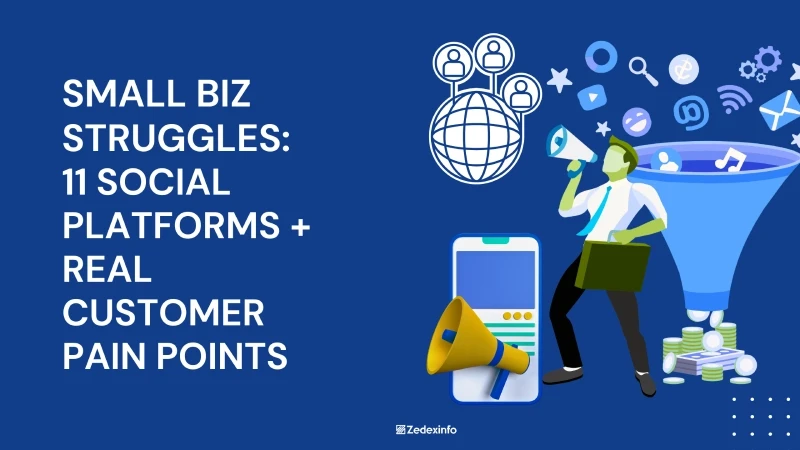Customer engagement, lead generation, and sales all benefit greatly from social media marketing. You may use social media to not only find new consumers, but also to engage with existing ones and extend their customer lifecycles. However, only a small percentage of social media marketers can claim to have reaped these benefits. Why? Pain-points. Here are the most common aches and pains you’re likely to encounter.
Every day, entrepreneurs and small enterprises in every field must deal with a plethora of problems. Digital marketing appears to be one of the most difficult concepts to understand. The majority of small businesses and entrepreneurs began as specialists in their field, and marketing was rarely required to finish the task. It’s tempting to disregard these issues and file them away in the “Not Now, Maybe Later” folder, but this mentality is what inhibits development and undermines profitability. Here are some frequent marketing problems that can and should be addressed immediately with appropriate solutions.
1. Safeguarding Resources and Time
According to an eMarketer poll, securing internal resources is extremely difficult for 46% of large organizations. That comes as no surprise. When was the last time you requested an additional hand for social media marketing from your supervisor? You may recall the agony of getting turned down after deficiently communicating your workload concerns if it wasn’t too long ago. Everybody thinks social media managers just tweet. Why would a business require more than one of those workers?
What is the most straightforward answer to this issue? Join a reputable social media management service. Choose one that automates/organizes your most time-consuming duties so you can focus on those that help you achieve your objectives.
2. Designing a Website that Converts
85 percent of customers rate a company’s credibility based on its internet presence, which includes third-party review sites and web design. Despite the fact that websites have become an indispensable tool for businesses, “demand for technological capabilities much outnumbers supply.” SMB (Small and midsize business) CEOs don’t have to be their own programmer, but they do need to understand web design concepts and how to improve user experience.
3. Customer And Search Engine-Friendly Content Creation
76 percent of B2B companies believe that creating content takes too long or requires too much effort. When time and money are already limited, it’s tempting for SMB CEOs to cut corners or join the minority of businesses who don’t create bespoke content. When expensive outsourcing to professionals or lowering content velocity is not an option for small business owners, they seek aid in giving more information.
4. Seeking Buy-In for Content Marketing
For many small company owners, in-house content generation is the greatest and most cost-effective alternative. Setting up a content culture, increasing staff buy-in, and developing a project management system for blogs and content offers all take time, but they’re necessary.
5. Buyer Personas Development
Consumer research businesses charge major corporations thousands of dollars to get market insights. SMB CEOs must rely on competition analysis and buyer persona profiles, which cover the pain issues, objectives, and demographics of their prospective consumers, due to a restricted budget for market research.
6. Customer Recommendation
The most qualified leads an SMB obtains are referrals from current customers. Referrals account for 65 percent of new business, and customers are four times more likely to buy after being suggested by a friend. SMB CEOs must work actively to identify qualifying referrals, establish tracking tools, and give incentives for suggestions.
7. Engage in Discussions With Your Audience
It is critical to express gratitude to your supporters. 58 percent of followers claim that the brand they tagged has never responded to them. This has a negative impact on consumers who may desire to purchase from the company again. Is it realistic to maintain a continual eye on your mentions? It is not possible if the firm is in the early stages of growth and has limited resources. However, in order for your brand to remain top of mind with your followers, customers, and potential interests, it requires care, validation, and nurturing.
8. Understanding Your Target Market
Your first aim should be to provide information about your company, and the product or service you’re selling. But how should such information be packaged? How do you make sure it gets the most traction possible? It’s when you communicate with your customers in their own language. But how can you figure out what works for your target market? How can you quantify and clearly state that this messaging and content connects the most with your target audience? This necessitates the alignment of goals, data, and reporting.
9. Enhancing Your Organic Exposure
There is a lot of noise on social media, with over a billion pieces of material uploaded on Facebook, Instagram, and Twitter alone. What makes you unique? Even if you’ve identified the correct audience, how do you approach them? Another dilemma that arises is whether it’s worth spending money on sponsored marketing if your organic postings aren’t doing well. These crucial decisions may create or shatter a brand’s social media influence.
10. Measurable KPIs Are Not Being Developed
Key performance indicators (KPIs) are a versatile technique for determining how successfully you’re accomplishing your business goals. It may sound overly complex, but it’s a tried-and-true method for determining effectiveness and tracking marketing ROI.
Solution: To analyze success across all marketing platforms, there are five KPI groupings. Lead creation, SEO optimization, paid advertising, website and traffic metrics, and social media tracking are among these areas. To enhance your results, track your progress and assess your efforts against these facts and best practices.
11. Lacking Concentration
With so much going on in the commercial and digital worlds, small company owners are inclined to seize every opportunity that comes their way. While having an open mind is a good attitude to have, many of these chances may just be diversions or possible traps.
Solution: One method to prevent becoming sidetracked is to set clear, attainable goals that are stretched out over a reasonable period. Set aside time, money, and resources to ensure that you achieve your objectives. You must establish and keep everyone in your organization on board with what you want to achieve with your marketing, regardless of the size of your business or consumer base.
And, more crucially, understand that good marketing is essential to the success of your company. There are problems in every firm. The goal is to address them as soon as possible so that your company can prosper in an increasingly competitive and technologically advanced environment. Your startup or small business may expand and produce profits by taking risks and enlisting the help of professional digital marketers.
Conclusion
To summarize, the above-mentioned social media sites and customer pain points for small businesses are critical to consider. Whether you run a small or large organization, you must examine all of the pain points.




